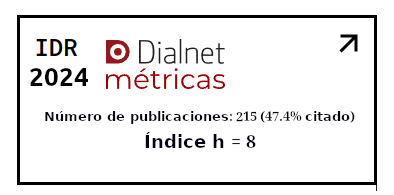Impulsivity and self efficacy in automobile drivers of Buenos Aires
Keywords:
Automobile driving; self efficacy; impulsivityAbstract
The purpose of this research work has been to evaluate Self-efficacy in driving, Impulsivity, and the relationship between both variables in Buenos Aires automobile drivers. Additionally, differences in the constructs were investigated according to sociodemographic variables - sex, age, educational level - and vial variables -number of claims and infractions- in the sample evaluated. The type of study carried out was non-experimental, descriptive-correlational, of differences between groups, and cross-sectional. Data was collected through simple non-probability sampling. 119 drivers participated (64.7% women and 35.3% men), residents of Buenos Aires, between 19 and 76 years old (M = 43.18; SD = 14.21). Locally adapted versions of the Self-Efficacy Scale for Driving and the Urgency, Sensation Search and Impulsiveness Questionnaire were administered, as well as a sociodemographic and road data survey. The results indicate a direct and significant association between Self-efficacy for driving and Search for Sensations, as well as the existence of significant differences according to sex, age, and educational level in the levels of Self-efficacy and Impulsivity.
Downloads
References
Araújo, M., Malloy-Diniz, L., y Rocha, F. (2009). Impulsiveness and traffic accidents. Revista de Psiquiatria Clínica, 36(2), 60-68. doi: 10.1590/S0101-60832009000200004.
Asociación Luchemos por la vida Asociación Civil. (2019). Relevamiento total de muertos anuales en la República Argentina. Recuperado de http://www.luchemos.org.ar/es/estadisticas/muertosanuales
Ball, I. L., Farnill, D., y Wangeman, J. F. (1984). Sex and age differences in sensation seeking: Some national comparisons. British Journal of Psychology, 75(2), 257–265. doi: 10.1111/j.2044-8295.1984.tb01897.x.
Beirness, D. (1993). Do we really drive as we live? The role of personality factors in road crashes. Alcohol, Drugs & Driving, 9(3-4), 129–143.
Chico-Librán, E. (2000). Búsqueda de sensaciones. Psicothema, 12(2), 229-235. Recuperado de http://www.psicothema.com/psicothema.asp?id=282
Correa-Díaz, G. (2010). Transporte y Ciudad. EURE, 36(107), 133-137. Recuperado de https://www.redalyc.org/pdf/196/19612544008.pdf
Deery, H. A. (1999). Hazard and risk perception among young novice drivers. Journal of Safety Research, 30(4), 225–236. doi: 10.1016/s0022-4375(99)00018-3.
Del Moral, M. (2019). Radiografía de las muertes viales en la Argentina: Casi la mitad son jóvenes e implican un gasto para el Estado de $175 mil millones. Recuperado de https://www.infobae.com/sociedad/2019/06/08/radiografia-de-las-muertes-viales-en-la-argentina-casi-la-mitad-son-jovenes-e-implican-un-gasto-para-el-estado-de-175-mil-millones/
Evenden, J. (1999). Impulsivity: A discussion of clinical and experimental findings. Journal of Psychopharmacology, 13(2), 180-192. Recuperado de http://journals.sagepub.com/doi/full/10.1177/026988119901300211?url_ver=Z39.88-2003&rfr_id=ori:rid:crossref.org&rfr_dat=cr_pub%3dpubmed
Horsthuis, S. (2011). De bijdrage van demografische en psychologische determinanten aan riskant rijgedrag door jonge en oudere automobilisten. (Tesis de doctorado inédita). Universidad de Twente, Holanda.
IBM Corporation. (2012). IBM SPSS Statistics (21). Recuperado de http://www-01.ibm.com/software/es/analytics/spss/
Kish, G. B., y Busse, W. (1968). Correlates of stimulus-seeking: Age, education, intelligence, and aptitudes. Journal of Consulting and Clinical Psychology, 32(6), 633–637. doi: 10.1037/h0026581.
Lajunen, T., y Parker, D. (2001). Are aggressive people aggressive drivers? A study of the relationship between self-reported general aggressiveness, driver anger and aggressive driving. Accident Analysis and Prevention, 33(2), 243–255. https://doi.org/10.1016/S0001-4575(00)00039-7.
Ledesma, R., Poó, F., y Peltzer, R. (2007). Búsqueda impulsiva de sensaciones y comportamiento de riesgo en la conducción. Avaliação Psicológica, 6(2), 117-125. Recuperado de https://www.researchgate.net/publication/283600267_Busqueda_impulsiva_de_sensaciones_y_comportamiento_de_riesgo_en_la_conduccion
Legislatura de la Ciudad de Buenos Aires. (2006). Ley Código de Tránsito y Transporte de la Ciudad Autónoma de Buenos Aires, N° 2148, 16 de noviembre de 2006.
Luego, M. A., Otero-López, J. M., Romero, E., y Gómez-Fraguela, J. A. 1996. Efectos de la necesidad de búsqueda de sensaciones sobre la involucración en el consumo de drogas de los adolescentes. Análisis y Modificación de Conducta, 22(86), 683-708. Recuperado de https://dialnet.unirioja.es/servlet/articulo?codigo=7072571
Macías, G., Almeida-Filho, N., y Alazraqui, M. (2010). Análisis de las muertes por accidentes de tránsito en el municipio de Lanús, Argentina, 1998-2004. Salud Colectiva, 6(3), 313-328. Recuperado de https://www.researchgate.net/publication/48169109_Analisis_de_las_muertes_por_accidentes_de_transito_en_el_municipio_de_Lanus_Argentina_1998-2004
Miles, D. E., y Johnson, G. L. (2003). Aggressive driving behaviors: are there psychological and attitudinal predictors? Transportation Research Part F: Traffic Psychology and Behaviour, 6(2), 147–161. doi: 10.1016/S1369-8478(03)00022-6.
Ministerio de Justicia y Derechos Humanos. (1994). Ley de Tránsito del Ministerio de Justicia y Derechos Humanos de Buenos Aires, Nº 24449, 23 de diciembre de 1994.
Ministerio de Transporte. (2016). Informe de gestión de seguridad vial. Recuperado de https://www.argentina.gob.ar/sites/default/files/ansv_2019_informe_de_gestion.pdf
Mognon, J. F., y Santos, A. (2014). Autoeficácia para dirigir, desengajamento moral e impulsividade em motoristas. Psico-USF, 19(3), 457–466. doi:10.1590/1413-82712014019003008.
OMS. (2015). Informe sobre la situación mundial de la seguridad vial 2015. Recuperado de https://www.who.int/violence_injury_prevention/road_safety_status/2015/Summary_GSRRS2015_SPA.pdf?ua=1
Pearson, M. R., Murphy, E. M., y Doane, A. N. (2013). Impulsivity-like traits and risky driving behaviors among college students. Accident Analysis & Prevention, 53, 142–148. doi:10.1016/j.aap.2013.01.009.
Roth, M., Schumacher, J., y Brähler, E. (2005). Sensation seeking in the community: Sex, age and sociodemographic comparisons on a representative German population sample. Personality and Individual Differences, 39(7), 1261–1271. doi:10.1016/j.paid.2005.05.003.
Sampieri, R., Collado, C., y Baptista, P. (2001). Metodología de la investigación. México: McGraw-Hill.
Smith, P., Waterman, M., y Ward, N. (2006). Driving aggression in forensic and non-forensic populations: Relationships to self-reported levels of aggression, anger and impulsivity. British Journal of Psychology, 97(3), 387–403. doi:10.1348/000712605x79111.
Squillace, M., y Picón-Janeiro, J. (2019). CUBI-18: Un instrumento para medir subtipos de impulsividad. Interdisciplinaria, 36(1), 43-58. Recuperado de https://www.redalyc.org/jatsRepo/180/18060087005/18060087005.pdf
Steinberg, L., Albert, D., Cauffman, E., Banich, M., Graham, S., y Woolard, J. (2008). Age differences in sensation seeking and impulsivity as indexed by behavior and self-report: Evidence for a dual systems model. Developmental Psychology, 44(6), 1764–1778. doi:10.1037/a0012955.
Trógolo, M., Medrano, L., y Ledesma, R. (2017). Propiedades psicométricas de una escala breve de autoeficacia para la conducción en conductores de Argentina. Liberabit, 23(1), 23-38. doi: 10.24265/liberabit.2017.v23n1.02.
Zuckerman, M., y Neeb, M. (1980). Demographic influences in sensation seeking and expressions of sensation seeking in religion, smoking and driving habits. Personality and Individual Differences, 1(3), 197–206. doi:10.1016/0191-8869(80)90051-3.
Published
How to Cite
Issue
Section
License
Copyright (c) 2020 ACADEMO Revista de Investigación en Ciencias Sociales y Humanidades

This work is licensed under a Creative Commons Attribution 4.0 International License.








